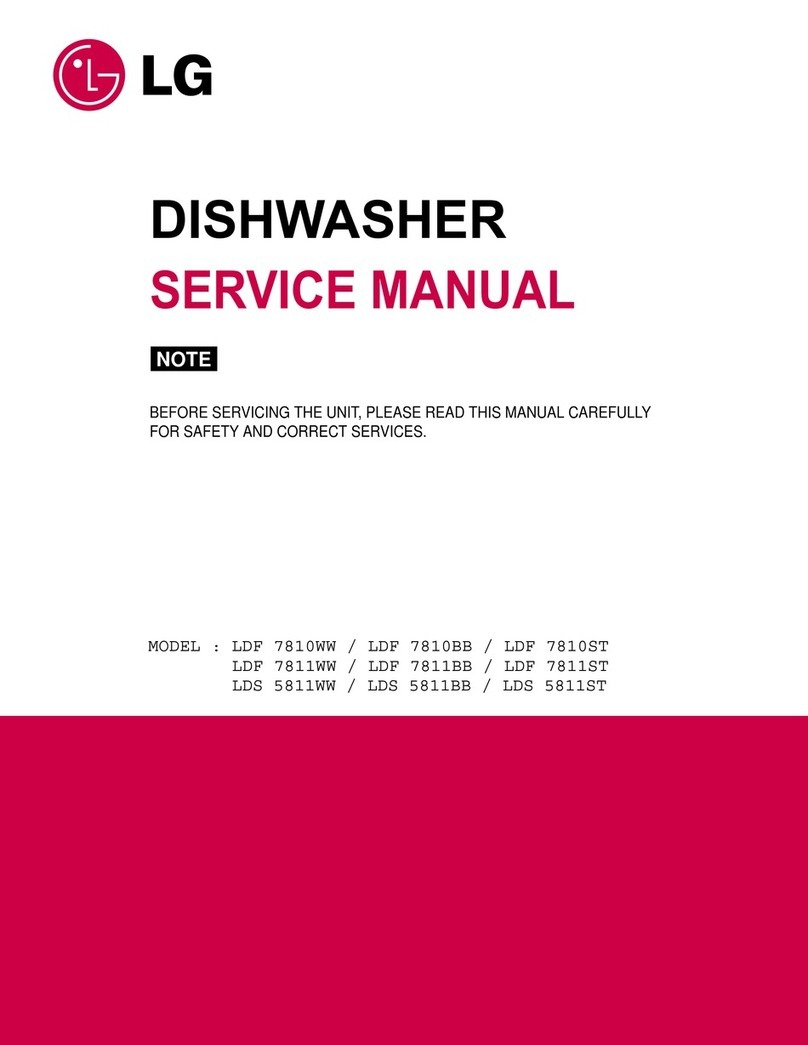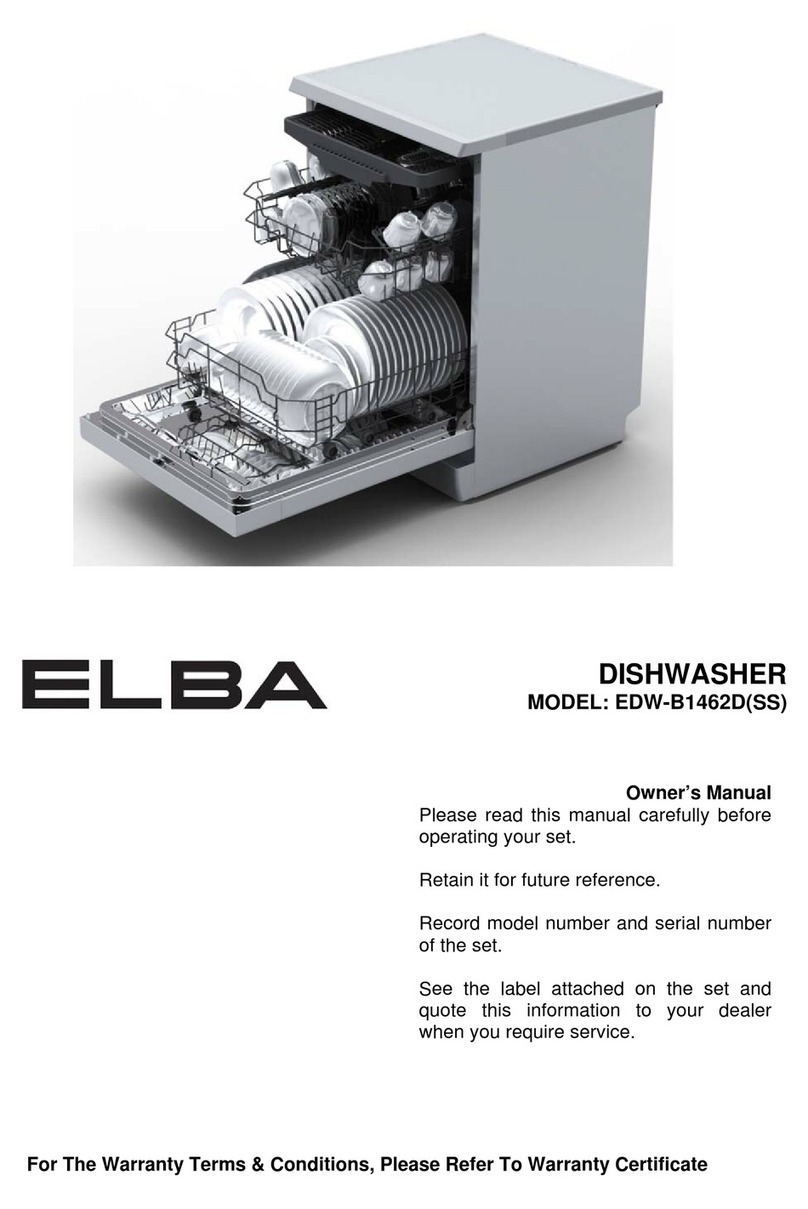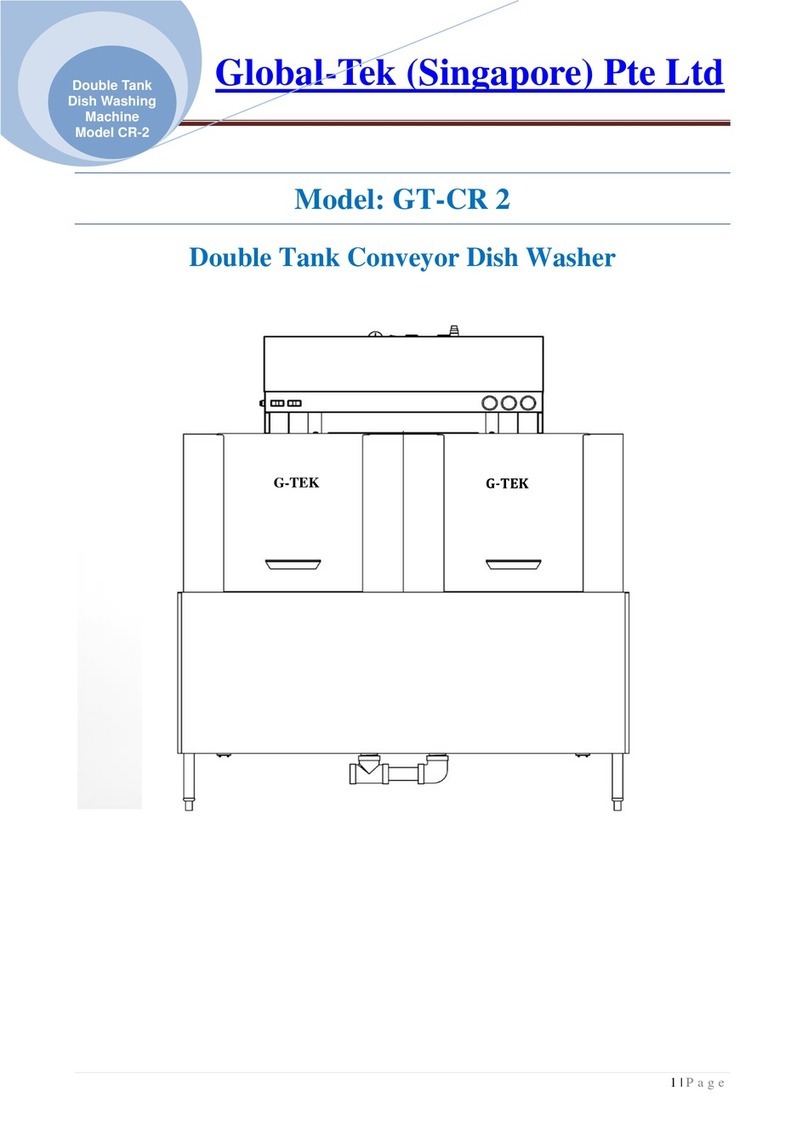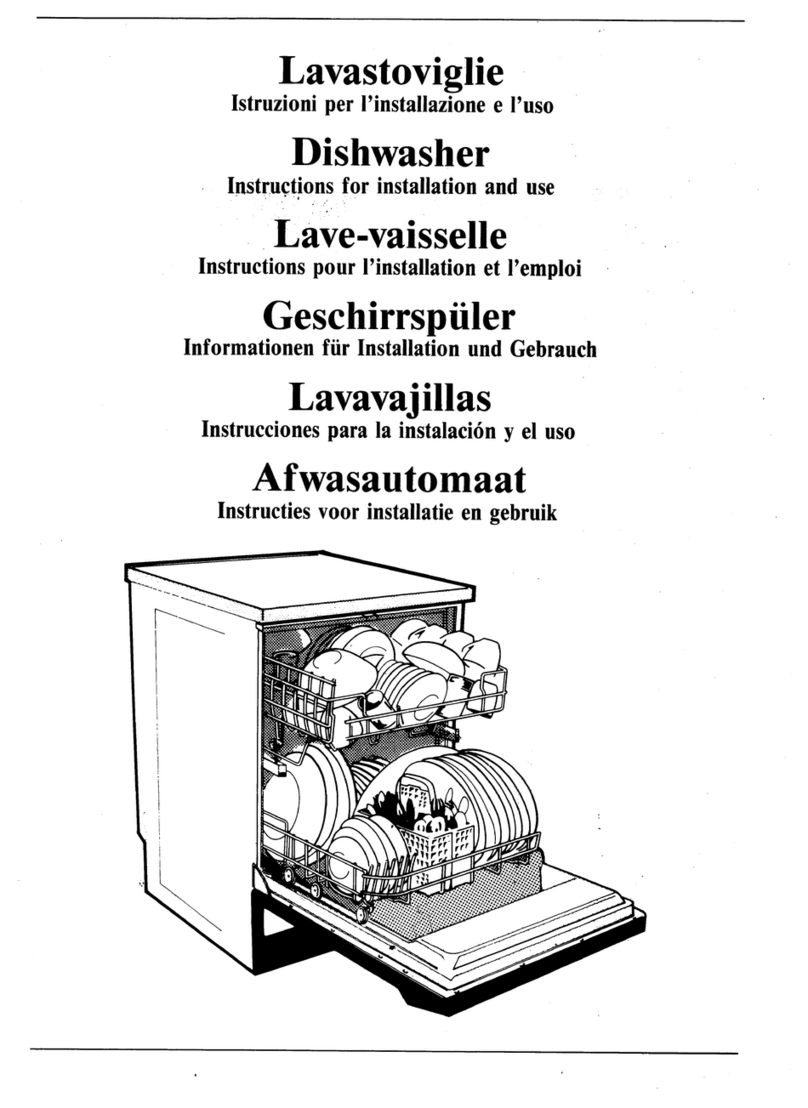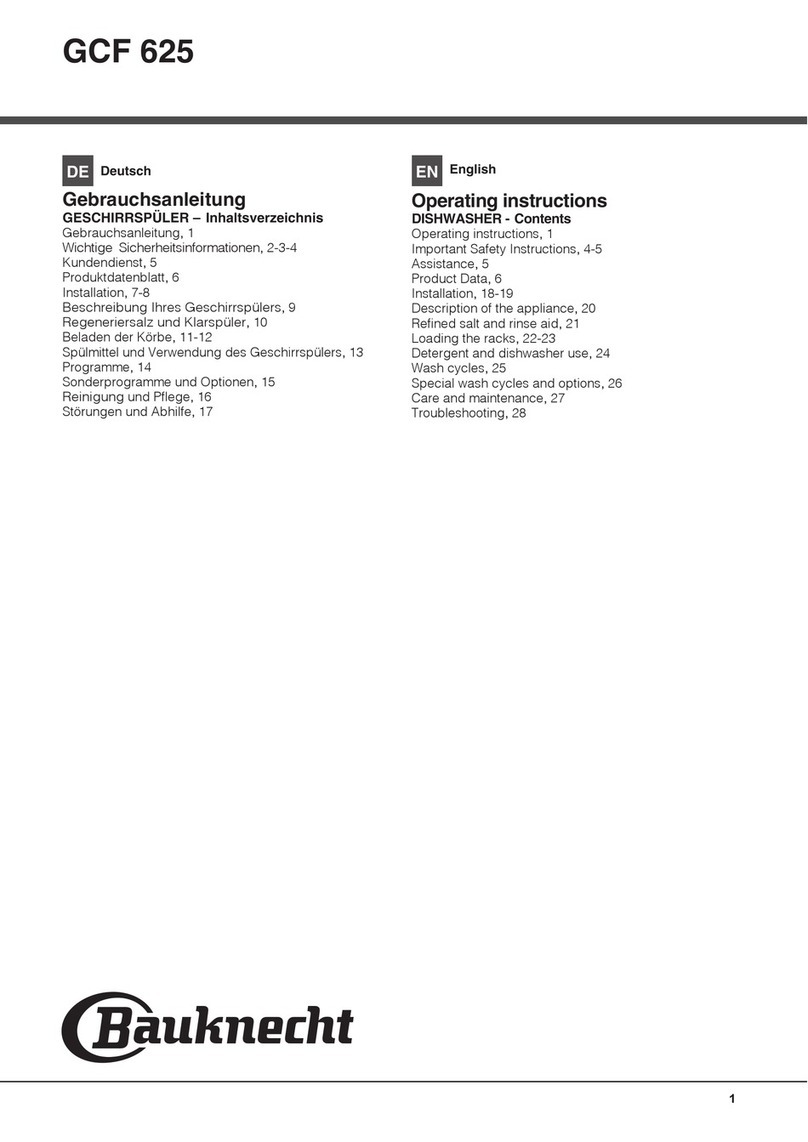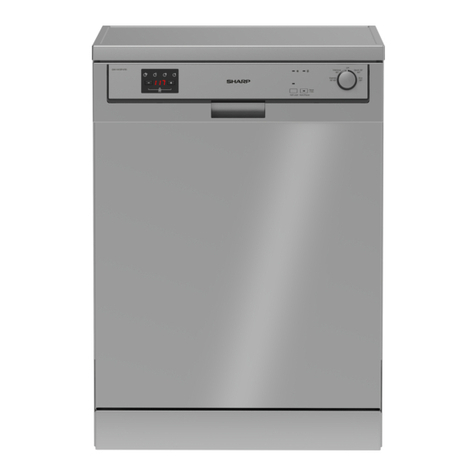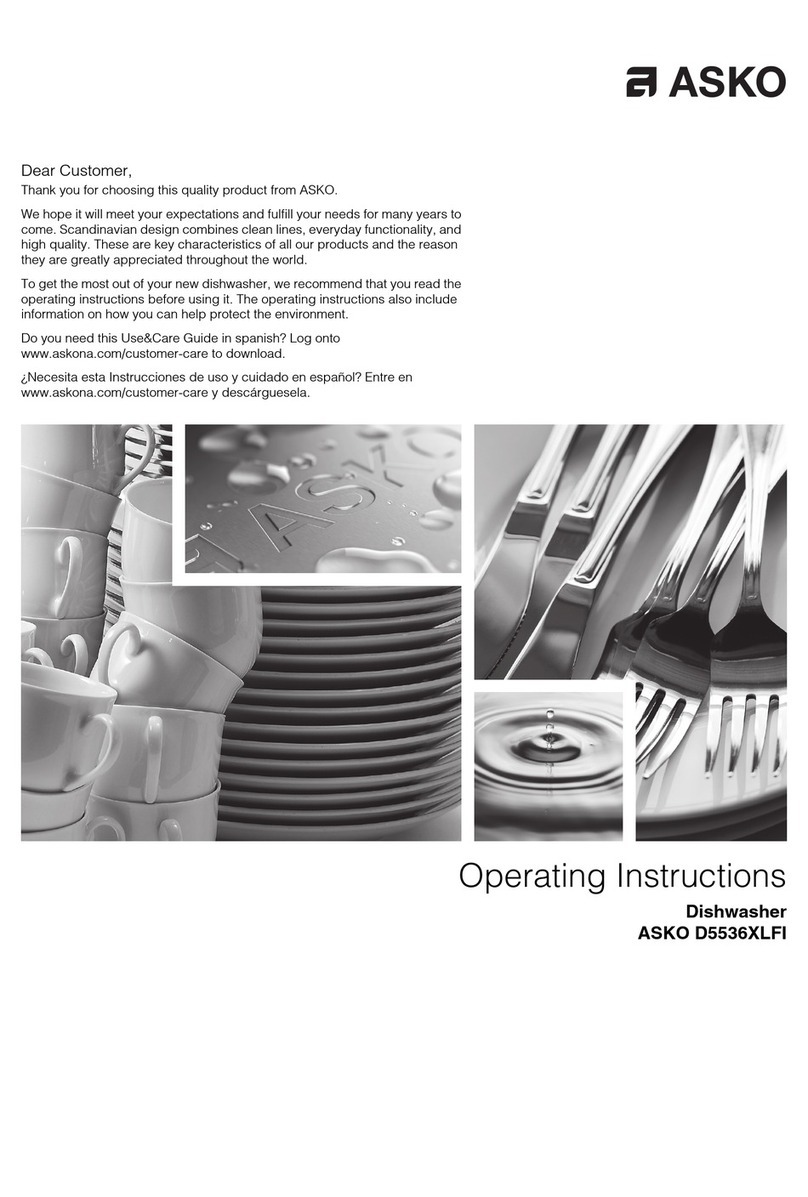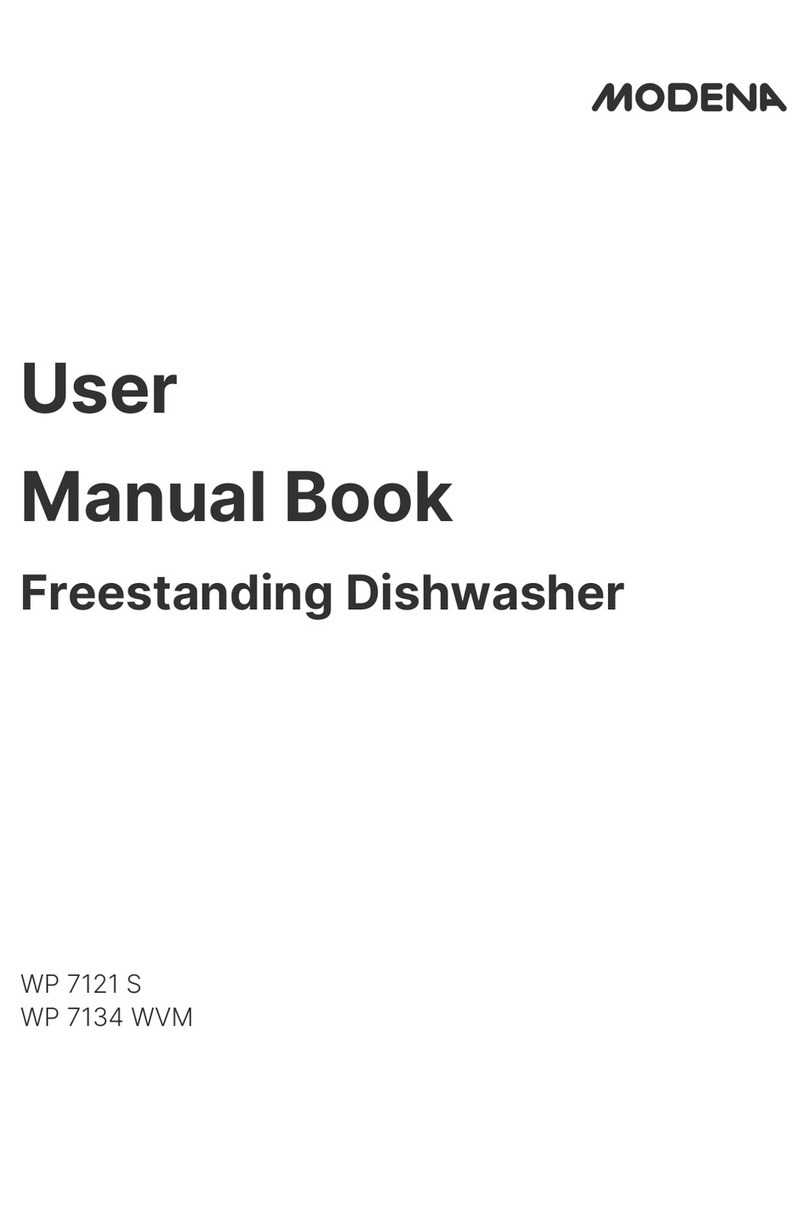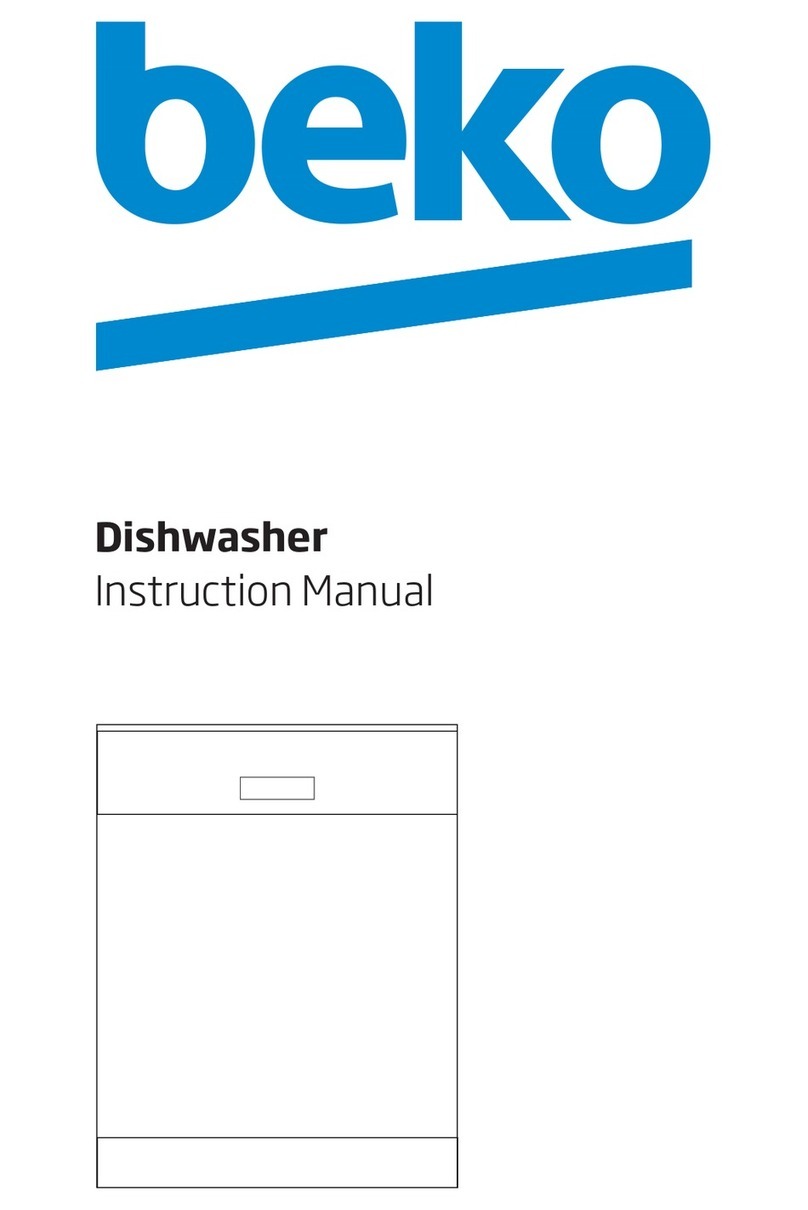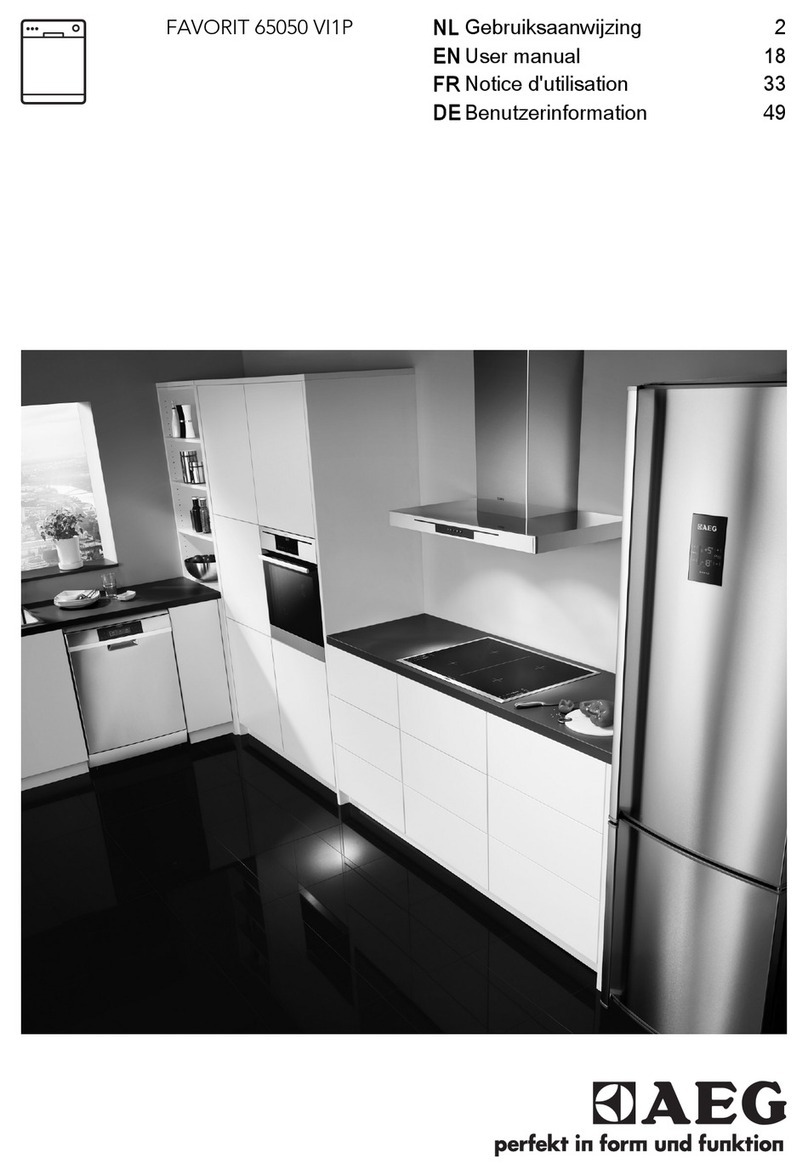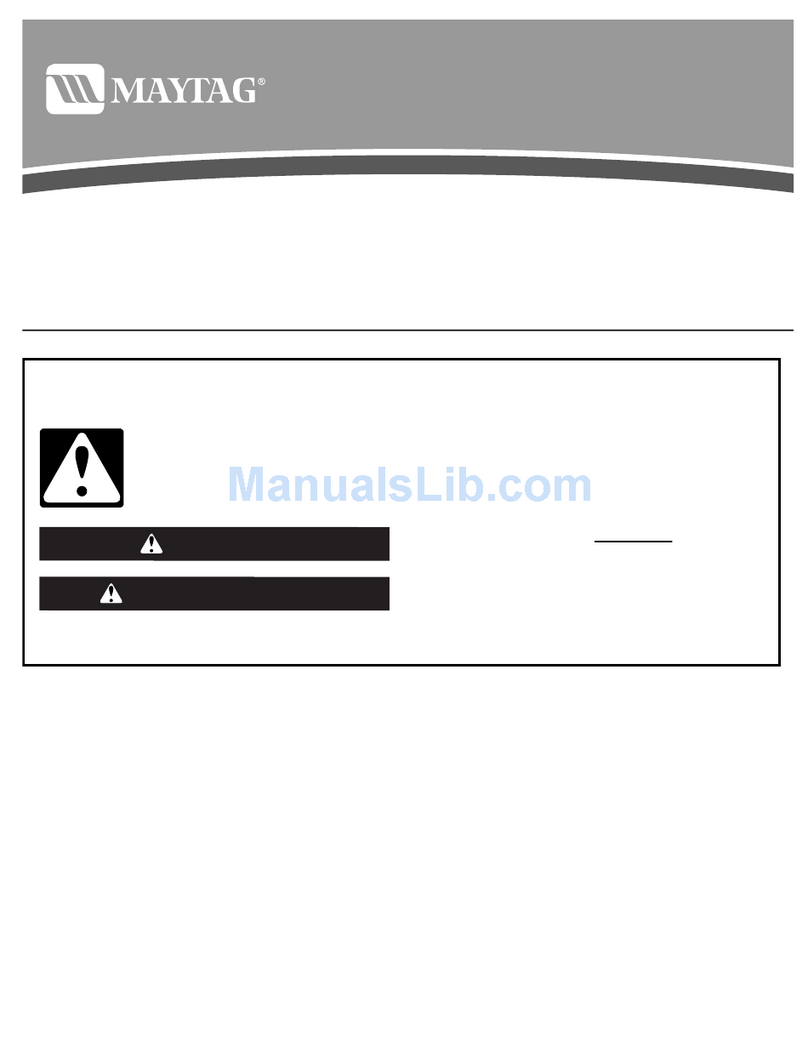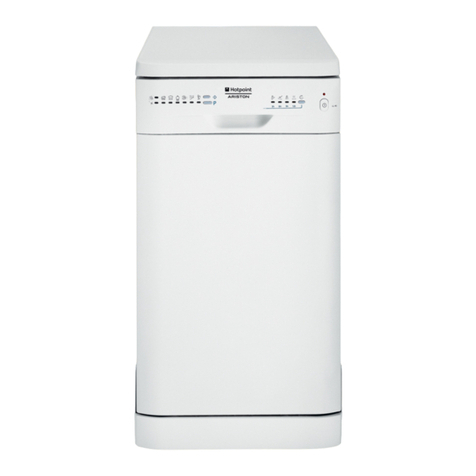Euro Appliances EDS45XS User manual

-
EMBRACE EUROPEAN QUALI+PASSION
www. eu roa ppli a nces.com .au
cooking
USE AND
CARE GUIDE
MODELNO.
EDS45XS

To review the section on troubleshooting Tips
will help youto solve somecommon problems
by yourself .
NOTE:
Dear Customer,
Please carefully read this manualbefore using the
dishwasher, itwill help youto use and maintain the
dishwasher properly.
Pass it on to any subsequent owner of the appliance.
This manual containssections on safetyInstructions,
Operating Instructions, InstallationInstructions and
Troubleshooting Tips, etc.
The manufacturer,following a policyof constant
development and updatingof the product, may
make modifications withoutgiving prior notice.
This user manualshall also begot from the
manufacturer or responsiblevendor.
Read this Manual
Before Calling for Service
Keep it to refer to it at a later date.
If you can not solve the problems by yourself ,
please ask forthe help ofprofessional technicians.
1) Safety Information......................................1
2) Quick operation guide.................................2
Loading the baskets according to (*AS/NZS 2007.1)
Dishwasher Features....................................... ..3
4) Prior usingfor the firsttime.............................4
5) Loading theDishwasher Basket...................7
7) Maintenance and cleaning..........................11
Filtering System...............................................11
Caring for the Dishwasher.................................12
A. Fill theRinse AidDispenser...........................4
B. Function of Detergent ...................................5
6) Starting awashing programme....................9
Wash Cycle Table...............................................9
Turning on the Appliance..................................10
Change the Programme....................................11
At the end of the Wash Cycle..............................11
8) Installation instruction...............................13
Positioning theAppliance.................................13
Water Connection............................................14
About Power Connection..................................13
Start of dishwasher..........................................15
9) TroubleshootingTips.................................16
Before calling for service...................................16
Error codes.....................................................17
Technicalinformation.......................................18
3) Operation Instruction..................................3
Control Panel.....................................................3
Recommengation..............................................7
For washing inthe dishwasher the
folliwing cutlery/dishes.....................................7
Attention before or after loading the
Dishwasher Baskets.........................................7
Removing the Dishes................................. .......7
The Method Loading Normal Dishware........... .....8

KEEP THESE INSTRUCTIONS
READ AND FOLLOW THIS SAFETY INFORMATION CAREFULLY
1.IMPORTANT SAFETY INFORMATION
READ ALL OF THE INSTRUCTIONS BEFORE USING
1.IMPORTANT SAFETY INFORMATION
READ ALL OF THE INSTRUCTIONS BEFORE USING
11
GROUNDING INSTRUCTIONS
This appliance must be grounded. In the event of a
malfunction or breakdown, grounding will reduce
the risk of anelectric shock by providing a path of
least resistance of electric current. This appliance
is equipped with a cord having an equipment-
grounding conductor and a grounding plug.
The plug must be plugged into an appropriate outlet
that is installed and grounded in accordance with
all local codes and ordinances.
WARNING!
WARNING! PROPER USE
Keep children away from detergent and rinse aid, keep
children away from the open door of the dishwasher,
there could still be some detergent left inside.
Do not abuse, sit on, or stand on the door or dish
rack of the dishwasher.
Do not touch the heating element during or
immediately after use.
(This instruction is only applicable to machines
with a visual heating element.)
Do not wash plastic items unless they are marked
dishwasher safe or the equivalent. For plastic items
not s
o m
arked, c
heck th
e m
anufacturer's
recommendations.
Use only detergent and rinse additives
designed for an automatic dishwasher.
Never use soap, laundry detergent, or hand
washing detergent in your dishwasher. Keep
these products out of the reach of children.
During installation, the power supply must not
be excessively or dangerously bent or flattened.
Do not tamper with controls.
Do not place any heavy objects on or stand on the
door when it is open. The appliance could tip
forward.
When loading items to be washed:
1) Locate sharp items so that they are not likely
to damage the door seal;
2) Warning: Knives and other utensils with
sharp points must be loaded in the basket
with their points down or placed in a
horizontal position.
When using yourdishwasher, youshould
prevent plastic itemsfrom coming intocontact
with the heating element.(This instruction is only
applicable to machineswith a visualheating
element.)
If the supply cord is damaged, it must be replaced
by the manufacturer or its service agent or a
similarly qualified person in order to avoid a
hazard.
Please dispose of packing materials properly.
Use the dishwasher only for its intended function.
Remove the door to the washing compartment when
removing an old dishwasher from service or discarding it.
Dishwasher detergents are strongly alkaline, they
can be extremely dangerous if swallowed. Avoid
contact with skin and eyes and keep children away
from the dishwasher when the door is open.
Check that thedetergent comparment isempty
after completion of the wash cycle.
The appliance is to be connected to the water
mains using newhose sets andthat old hose-sets
should not be reused.
The maximum number of place settings to be
washed is 10.
The maximum permissible inlet water pressure is
1Mpa.
The minimum permissible inlet water pressure is
0.04Mpa.
Children should be supervised to ensure that they do
not play with the appliance.
This appliance is not intended for use by persons
(including children )with reduced physical, sensory or
mental capabilities, or lack of experience and
knowledge ,unless they have been given supervision
or instruction concerning use of the appliance by a
person responsible for their safety.
When using your dishwasher, follow the precautions listed below:
WARNING!WARNING!
The door should not be left open,
since this could increase the risk of tripping.
Improper connection of the equipment-grounding
conductor can result in the risk of an electric shock.
Check with a qualified electrician or service
representative if you are in doubt whether the
appliance is properly grounded. Do not modify the
plug provided with the appliance; If it does not fit
the outlet. Have a proper outlet installed by a
qualified electrician.
Do not operate your dishwasher unless all
enclosure panels are properly in place. Open
the door very carefully if the dishwasher is
operating, there is a risk of water squirting out.

22
2.Quick operation guide2.Quick operation guide
For detailed operating method read the corresponding content on the instruction manual.
Compartment A:Compartment A:
For each wash cycle.
Compartment B:B:
For programs with pre-wash only.
(Follow the user instructions)
Mechanical indicator C.Mechanical indicator C.
Electric indicator on control panel (if provided).
Check the rinse aid level
Load the baskets
Select a program
Running the dishwasher
Switch off the appliance
Turn off the water tap,
unload the baskets
Fill the detergent dispenser
Warning: wait a few minutes (about 15 minutes) before unloading the dishwasher to avoid scald,as
the dishes and utensils are still hot and more susceptible to break.
They could also dry better.Unload the appliance, starting from the lower basket.
Changing the program
Add forgotten dishes in the
dishwasher.
Scrape off any large food particles. Soften remnants of burnt food in pans,
then load the baskets. Refer to the dishwasher loading instructions.
When the working cycle is finished, the buzzer of the dishwasher will sound 8 times, then stop.
Turn off the appliance using the On/Off Button.
Since the appliance is standing by, it will power off automaticly after 30 minutes without any operation.
If the appliance is switched
off during a wash cycle.
Open the doorcarefully.
Hot steam mayescape
when the dooris opened!
WARNING!
If the appliance is switched off during a wash cycle, when switched
on again, please re-select the washing cycle and operate the dishwasher
according to the original Power-on state ).
Switch on the appliance
Open the door, press the On/Off button to switch on the appliance.
T urn on the water tap and press the Start/Pause Button. The machine will start working after about
10 seconds.
Close the door,press the Program Button until the selected program lights up.
( See the section entitled Operation instruction )
1. A running cycle can only be modified if it has been running for a short time. Otherwise the detergent
may have already been released and the water already drained. If this is the case, the detergent
dispenser must be refilled.
2. Press the Start/Pause button then press the program button for more than 3 seconds to cancel the
running programme.
3. Select a new programme.
4. Restart the dishwasher.
1.Press the start/pause button to stop the machine.
2.Open the door.
3.Add the forgotten dishes.
4.Close the door, then press the start/pause button, the dishwasher will
start running again
AB
C

33
3.Operation Instruction3.Operation Instruction
before using it for the first time.
To get the best performance from your dishwasher, read all operating instructions
IMPORTANTIMPORTANT
Control PanelControl Panel
Dishwasher FeaturesDishwasher Features
Attention:
Child lock function: Press Delay button and
button simultaneously
to lock the program.
Extra drying/Strong washfunction
2.Delay Button : Press the button to add the delaytime.
1. On/Off Button: To switch On/Off the appliance.
6.Display screen: Toshow the reminding time and
the state(running state, delay time,error codes etc )
3.Extra drying/ Strong wash function Button: To choose
the extra dryingfunction or thestrong wash function.
8.Extra drying indicators: To show whenyou choose
the extra drying function .
9.Program indicators: To show which program you have
chose.
10.Other indicators:
Rinse Aid indicator:
Indicates when the dispenser needs to be refilled.
Child lock indicator:
Water faucet indicator:
Indicates when the water faucet does not open.
4.Program Button :To Press the button toselect
appropriate Program.
5.Start /Pause button:To start theselected
washing program or pause the washing program
when the machine is working.
112233
66778899
4455
1010
7.Strong wash indicators: To show whenyou choose
the strong wash function .
Back View
1
2
3
4
5
6
7
89
Front view
Lower basket
Dispenser
Cup shelf
Spray arms
Filter assembly
Inlet pipe connector
Drain pipe
Upper basket
Cutlery rack
Topspray arm
1Inner pipe
5
6
7
8
9
11
10
3
2
4
Adjuster
12
12
10
11

44
4.Prior using for the first time4.Prior using for the first time
Before using your dishwasher for the first time:
A. Fill the rinse aid dispenser
B. Fill in detergent
A. Rinse Aid DispenserA. Rinse Aid Dispenser
The rinse aid is released during the final rinse to prevent water from forming droplets on your dishes, which can
leave spots and streaks. It also improves drying by allowing water to roll off the dishes. Your dishwasher is
designed to use liquid rinse aids. The rinse aid dispenser is located inside the door next to the detergent dispenser.
To fill the dispenser, open the cap and pour the rinse aid into the dispenser until the level indicator turns completely
black. The volume of the rinse aid container is about 110ml.
Rinse AidDispenser
Function of Rinse Aid
Rinse aid is automatically added during the last rinse, ensuring thorough rinsing, and spot and streak free drying.
Attention!
Only use branded rinse aid for dishwasher. Never fill the rinse aid dispenser with any other substances
(e.g. Dishwasher cleaning agent, liquid detergent). This would damage the appliance.
As the rinse aid diminishes, the size of the black dot
on the rinse aid level indicator changes, as illustrated below.
Full
3 / 4 fu ll
1 / 2 fu ll
1 / 4 full - Should refill to eliminate spotting
Empty
If there is no rinse-aid warning light in the control panel, you can judge the amount of rinse-aid by the color of the
optical level indicator "C" located next to the cap. When the rinse-aid container is full, the whole indicator will be
dark .As the rinse-aid diminishes, the size of the dark dot decreases. Youshould never let the rinse aid get below
1 / 4 full.
When to Refill the Rinse Aid Dispenser
How to fill the Rinse Aid Dispenser
To open the dispenser, turn the cap to the "open" (left) arrow and lift it out.
Pour the rinse aid into the dispenser, being careful not to overfill.
Replace the cap by inserting it aligned with "open" arrow and turning it to the closed (right) arrow.
Be careful not to overfill the dispenser, because this could cause over sudsing. Wipe away any spills
with a damp cloth. Don't forget to replace the cap before you close dishwasher door.
Attention!
Clean up any rinse aid spill during filling with an absorbent cloth to avoid excess foaming during the next wash.
1
2
3
C (Rinse-Aid indicator)C

55
Adjusting Rinse Aid Dispenser
The rinse aid dispenser has six or four settings. Always start with the dispenser
set on "4". If spots and poor drying are a problem, increase the amount of rinse
aid dispensed by removing the dispenser lid and rotating the dial to "5". If the
dishes still are not drying properly or are show spots, adjust the dial to the next
higher lever until your dishes are spot-free. The recommended setting is "4".
(Factory value is "4".)
Increase the dose if there are drops of water or lime spots on the dishes after washing.
Reduce it if there are sticky whitish stains on your dishes or a bluish film on glassware or
knife blades.
Adjust lever
(Rinse)
Adjust lever
(Rinse)
during the next wash. Don't forget to replace the cap before you close dishwasher door.
Clean up any rinse aid spilled while during filling with an absorbent cloth to avoid excessive foaming
NOTE:NOTE:
NOTE:NOTE:
Detergents have chemical ingredients that are necessary to remove dirt, crush dirt and transport it out of the dishwasher.
Most of the commercial quality detergents are suitable for this purpose.
B. DetergentB. Detergent
Detergents
There are 3sorts of detergents
1.With phosphate and with chlorine
2.With phosphate andwithout chlorine
3.Without phosphate and without chlorine
MAXMAX
Based on theirchemical composition, detergents can be split in two basic types:
The use of normal washing programs incombination with concentrated detergents
reduces pollution and is good for your dishes; these wash programs are specifically matched
to the dirt-dissolving properties of the enzymes ofthe concentrated detergent. For this reason
normal wash programs in which concentrated detergents are used can achieve the same
results that can otherwise only be achieved using intensive programs.
Detergent tablets ofdifferent brands dissolve at different speeds. For this reason some
detergent tablets cannotdissolve and develop their full cleaning power during short
programs. Therefore please use long programs when using detergent tablets, to
ensure the completeremoval of detergent residuals.
The dispenser mustbe refilled before the start of each wash cycle following the instructions
provided in the wash cycle table . Your dishwasher uses less detergent and rinse aid than
Conventional dishwasher. Generally, only one tablespoon of detergent is needed for
a normal wash load. More heavily soiled items need more detergent. Always add the
detergent just before starting the dishwasher, otherwise it could get damp and will not
dissolve properly.
Concentrated Detergent
Detergent Tablets
Detergent Dispenser
Conventional, alkaline detergents with caustic components
Low alkaline concentrated detergents with natural enzymes
Normally new pulveriseddetergent is without phosphate. Thus the water softener function of
phosphate is notgiven. If detergents without phosphate are used in the case of hard water
often white spotsappear on dishes and glasses. In this case please add more detergent to reach
better results. Detergentswithout chlorine do only bleach a little. Strong and coloured spots will not
be removed completely. In this case please choose a programwith a highertemperature.

66
Adding detergent to dispenser
Proper Use of Detergent
Use only detergentspecifically made forthe use indishwashers. Keep yourdetergent fresh anddry.
Don't put powdereddetergent into thedispenser until you'reready to washdishes.
Dishwasher detergent is corrosive!
Take care to keep it out of reach of children.
WARNING!WARNING!
Always add the detergent just before starting each wash cycle.
Only use branded detergent and rinse aid for dishwasher.
If the lid is closed: push the latch to open.
NOTE:NOTE:
Fill the detergentdispenser with detergent.
The marking indicates the dosing levels , as
illustrated on theright:
For main washdetergent.
For pre-wash detergent.
Please observe the manufacturers dosing and storage
Recommendations as stated on the detergent packaging.
Close the lid and press until it locks in place.
If the dishes are heavily soiled, place an additional
detergent dose inthe pre-wash detergent chamber. This detergent will take effect during the pre-wash phase.
A
B
Fill in Detergent
You see information about the amount of detergent for the single programmeon page 9.
Please be awarethat soiling levelsand water hardnesscan effect wash results.
Please observe themanufacturer's recommendations onthe detergent packaging.
Push latch to openPush latch to open
AABB

5.Loading the Dishwasher Baskets5.Loading the Dishwasher Baskets
For washing in the dishwasher the following cutlery/dishesFor washing in the dishwasher the following cutlery/dishes
Cutlery with wooden, horn china or
mother-of-pearl handles
Plastic items that are not heat resistant
Older cutlery with glued parts that are not
temperature resistant
Bonded cutlery items or dishes
Pewter or copperitems
Crystal glass
Steel items subject to rusting
Wooden platters
Items made from synthetic fibres
Some types ofglasses can become
dull after a large number of washes
Silver and aluminumparts have a
tendency to discolour during washing
Glazed patterns may fade if machine
washed frequently
Are not suitable Are of limited suitability
Dishes and items of cutlery must not lie inside one another, or cover each other.
To avoid damage to glasses, they must not touch.
Load large itemswhich are mostdifficult to clean into thelower basket.
The upper basket is designed to hold more delicate and lighter dishware such as glasses, coffee
and tea cups
Long bladed knives stored in an upright position are a potential hazard!
Long and/or sharp items of cutlery such as carving knives must be positioned
horizontally in theupper basket.
Please do not overload your dishwasher. This is important for good results and for
reasonable consumption of energy.
Load hollow itemssuch as cups,glasses, pans etc.With the opening facing downwards so that
water cannot collect in the container or a deep base.
RecommendationRecommendation
Consider buying utensilswhich are identified as dishwasher-proof.
Use a mild detergent that is described as 'kind to dishes'. If necessary, seek further
information from thedetergent manufacturers.
For particular items, select a program with as low a temperature as possible.
To prevent damage, do not take glass and cutlery out of the dishwasher immediately
after the programme has ended.
(For best performance of the dishwasher, followthese loading guidelines.
Features and appearanceof baskets and cutlery baskets may vary from your model.)
Scrape off any large amounts of leftover food. Soften remnants of burnt food in pans.
It is not necessary to rinse the dishes under running water.
Place objects inthe dishwasher in following way:
1.Items such as cups, glasses, pots/pans, etc. are faced downwards.
2.Curved items,or ones withrecesses, should be loaded aslant so that water can run off.
3.All utensils are stacked securely and can not tip over.
4.All utensilsare placed inthe way that the sprayarms can rotate freely duringwashing.
NOTE:NOTE:
Very smallitems should notbe washed in the dishwasher as they could easily fall out of the basket.
Attention before or after loading the Dishwasher BasketsAttention before or after loading the Dishwasher Baskets
Toprevent water drippingfrom the upper basket into the lower basket, we recommend that you
empty the lowerbasket first andthen the upperbasket.
Removing the DishesRemoving the Dishes
77

88
The upper basketis designed to hold more delicate
and lighter dishware such as glasses, coffee and
tea cups and saucers, as well as plates, small bowls
and shallow pans(as long as they are not too dirty).
Position the dishes and cookware so that they will
not get moved by the spray of water.
Loading the Upper BasketLoading the Upper Basket
We suggest that you place large itemsand the most
difficult to clean items are to be placed into the lower
basket: such as pots, pans, lids, serving dishes and
bowls, as shownin the figurebelow. Itis preferable to
place serving dishesand lids onthe side of the racks
in order to avoid blocking the rotation of the top spray
arm.
Loading the Lower BasketLoading the Lower Basket
Pots, serving bowls, etc, must always be placed top down.
Deep pots should be slanted to allow water to flow out.
Please be remindedthat:
The Bottom Basket features folding spikes sothat larger or more pots and pans can be loaded.
The Method Loading Normal DishwareThe Method Loading Normal Dishware
IN
Adjusting the Upper Basket
The height of the upper basket can be adjusted in order to
create more space for large utensils both for the upper
/lower basket. The height of the upper basket can be
adjusted by placing the wheels on different height of the
rails. Long items, serving cutlery, salad servers and knives
should be placed on the shelf so that they do not obstruct
the rotation of the spray arms..
Lower positionLower position Upper positionUpper position
WheelsWheels
Folding back the cup shelves
For better stacking of pots and pans,
the spikes can be folded down as
show in the picture right.
Cutlery should be placed in the cutlery rack separately
from each other in the appropriate positions, and do
make sure the utensils do not nest together, this may
cause bad performance.
Cutlery BasketCutlery Basket
For a top quality cleaning, place the silverware in the basket
making sure that:
For a top quality cleaning, place the silverware in the basket
making sure that:
They do not nest together.They do not nest together.
Silverware is placed with the male face up.Silverware is placed with the male face up.
Long utensils in the middle.Long utensils in the middle.
IN

6.Starting a washing program6.Starting a washing program
Wash Cycle TableWash Cycle Table
NOTE:NOTE:
Means: Rinse-aid dispenser needs to be filled.
( )
NOTE:NOTE:
* : This program is the test cycle. The information forcomparability test
in accordance with , as follows:
Capacity: 10 settings
Position Upper basket: upper wheels on rails
Rinse aid setting: 6
PI:0.49w;Po:0.45w
99
Turning On the ApplianceTurning On the Appliance
Starting a cyclewash
Draw out thelower and upperbasket, load thedishes and pushthem back.
It is commendedto load thelower basket first,then the upperone (see the section entitled
Loading the Dishwasher ).
Pour in thedetergent (see thesection entitled Detergent and RinseAid ).
Insert the pluginto the socket.The power supply is 220-240 VAC /50 HZ, the specification
of the socketis 10A 250VAC. Make sure that the water supply is turned on to full pressure.
Close the door, press the On/Off button to switchon the machine.
Press the programbutton , the wash program will be changed as follows direction:
Intensive->Heavy->ECO->Glass->90 Min->Rapid->Soak;
If a programis selected, theresponse light will light on. Then press the Start/Pause button, the
dishwasher begins tostart.
1
2
3
4
5
Glass
Detergent
pre/main
Detergent
pre/main
Cycle Selection
Information
Cycle Selection
Information
ECO
ProgramProgram
Intensive
Heavy
Running
time(min)
Running
time(min) Water
(L)
Water
(L)
Energy
(Kwh)
Energy
(Kwh)
Rinse
Aid
Rinse
Aid
Rapid
Description
of Cycle
Description
of Cycle
(*AS/NZS 2007.1)
For lightly soiledloads,
such as glasses,
crystal and fine china.
Pre-wash
wash(40 )
Rinse
Rinse(60 )
Drying
125
0.75 12
For normally soiled loads,
such as pots, plates, glasses
and lightly soiled pans.
standard daily cycle.
For the heaviest soiled
loads, such as pots, pans,
casserole dishes and dishes
that have been sitting with
dried food on them for a
while.
A shorter wash for lightly
soiled loads that do not
need drying.
Pre-wash(50 )
Wash (60 )
Rinse
Rinse
Rinse(70 )
Drying
Pre-wash(45 )
Wash (55 )
Rinse
Rinse (65 )
Drying
Pre-wash
Wash (45 )
Rinse(45 )
Drying
Wash (45 )
Rinse (50 )
Rinse (55 )
180
180
170
30
1.1
0.506
1.4
0.7
15.5
12
11
10
Wash(65 )
Rinse
Rinse (65 )
Drying
90 11. 5
1.15
27g
20g
For heavily soiled loads,
such as pots, plates, glasses
and lightly soiled pans.
To rinse dishes that you plan
to wash later that day..
Pre-wash
15 0.02 3.5
Soak
For lightly soiled crockery
and glass.
90 min
//
//
//
1 piece
1 piece
5/22.5g
1 piece
5/22.5g
1 piece
5/22.5g
1 piece
5/22.5g

1010
When the workingcycle has finished,the buzzer of the dishwasher will sound for 8 seconds, then stop. Turn off
the appliance using the ON/OFF button, shut off the water supply and open the door of the dishwasher.
Wait for a few minutes before unloading the dishwasher to avoid handling the dishes and utensils while they
are still hot and more susceptible to breakage. They will also dry better.
Switch Off the Dishwasher
The program light is on but is not blinking, only in this case the programme has ended.
1.Switch off the dishwasherby pressing theON/OFF Button.
2.Turn off the water tap!
Open the door carefully.
Hot dishes aresensitive to knocks. The dishes should therefore be allowed to cool down around 15 minutes
before removing from the appliance.
Open the dishwasher'sdoor, leave it ajar and wait a few minutes before removing the dishes. In this way they
will be cooler and the drying will be improved.
Unloading the dishwasher
It is normal that the dishwasher is wet inside.
Empty the lowerbasket first andthen the upper one. This will avoid waterdripping from the upper Basket onto
the dishes in the lower one.
Forgot to Add a DishForgot to Add a Dish
At the End of the Wash CycleAt the End of the Wash Cycle
A forgotten dish can be added any time before the detergent cup opens.
Add forgotten dishes.
Close the door
After the spray arms stop working, you can open the door
completely.
2
3
Open the door a little .
14
5
6
Press the Start/Pause Button to stop the washing.
Press the Start/Pause Button, the dishwasher will start
running at once.
WARNING!WARNING!
It is dangerous to open the door when washing, as hot water may scald
you.
Change the Program Mid-CycleChange the Program Mid-Cycle
When you pressthe Start/Pause button to pause during washing,
you press theStart/Pause button tostart.
The program light will stop blinking and the
buzzer will mooingevery minute unless
NOTE:NOTE:
If your model has broken remember function, the machine will go on to finish the selected
program after the power cut.
If you open the door during a wash cycle , the machine will pause. The program light will
stop blinking and the buzzer will mooing every minute unless you close the door . After
you close the door ,the machine will keep on working after 10 seconds.
NOTE:NOTE:
Premise:
A cyclethat is underwaycan only bemodified if ithas only beenrunning for ashort time. Otherwise,the
detergent may have already been released, and the appliance may have already drained the wash water.
If this is the case, the detergent dispenser must be refilled (see the section entitled " Loading the
Detergent " ).
Press the Start/Pause button , the machine will pause, press the program button more than 3s then you
can change the program to the desired cycle setting (see the section entitled " Starting a wash cycle. . ." ).
1
2

The filter preventslarger remnants offood or otherobjects from gettinginside the pump.
The residues may block the filter, in this case they must be removed.
The filter system consists ofa coarse filter,a flat (Main filter)
And amicrofilter(Fine filter).
Food and soil particles trapped in this filter are pulverized by a
special jet on the lower spray arm and washed down to drain.
Larger items, suchas pieces ofbones or glass,that could block
the drain aretrapped in thecoarse filter.To remove the items
caught by thefilter, gentlysqueeze the tapon the topof this
filter and liftout.
This filter holds soil and food residues in the sump area and
prevents it from being deposited on the dishes during wash cycle.
Main filter 1
Coarse filter 2
Fine filter 3
2
3
1
Filter assembly
The filter efficiently removes food particles fromthe wash water, allowing itto be recycled during the cycle.
For best performanceand results, thefilter must becleaned regularly. For this reason, it is a good idea to
remove the largerfood particles trappedin the filterafter each washcycle by rinsingthe semicircular filterand
cup under runningwater. To remove the filter device, pull the cup handle in the upward direction.
WARNING!WARNING!
The dishwasher must never be used without the filters.
Improper replacement of the filter may reduce the performance level of the appliance
and damage dishes and utensils.
nn
nn
1
2
Step 1 Turn the filter in anti-clockwise direction,
Step 2 lift the filterassy up
7.Maintenance and Cleaning7.Maintenance and Cleaning
Filtering SystemFiltering System
NOTE:NOTE:
When following this procedure from step1 to step 2, the filter system will be removed;
when following it from Step 2 to Step 1, the filter system will be installed.
1111
OpenOpen

The control panel can be cleaned by using a lightly dampened cloth.
After cleaning, make sure to dry it thoroughly.
For the exterior, use a good appliance polish wax.
Never use sharp objects, scouring pads or harsh cleaners on any part of the dishwasher.
Protect AgainstFreezing
1.Cut off the electrical power to the dishwasher.
2.Turn off the water supply and disconnect the water inlet pipe from the water valve.
3.Drain thewater from the inlet pipe and water valve. (Use a pan to gather the water)
4.Reconnect the water inlet pipe to the water valve.
5.Remove thefilter at the bottom of the tub and use a sponge to soak up water in the sump.
please take frostprotection measures onthe dishwasher in winter. Every time after washing cycles,
please operate as follows
Caring for the DishwasherCaring for the Dishwasher
Cleaning the Filter
Cleaning the Door
Toclean the coarsefilter and thefine filter,use a cleaningbrush. Reassemble thefilter parts (see page 11) and
reinsert them inthe dishwasher,positioning them intheir seat andpressing downwards.
When cleaning the filters, don't knock on them. Otherwise, the filters could be
contorted and the performance of the dishwasher could be decreased.
WARNING!WARNING!
To clean the edge around the door, you should use only a soft warm, damp cloth.
To avoid penetration of water into the door lock and electrical components, do not
use a spray cleaner of any kind.
WARNING!WARNING!
Never use a spray cleaner to clean the door panel as it may damage the door lock
and electrical components.
Abrasive agents or some paper towels should not be used because of the risk of
scratching or leaving spots on the stainless steel surface.
nn
nn
Cleaning the Spray Arms
NOTE:NOTE:
If your dishwasher cannot work because of the ice,
please contact professional service persons.
It is necessaryto clean thespray arms regularlyfor hard
water chemicals willclog the sprayarm jets andbearings.
- Inspect the filters for blocking after every time the dishwasher has been used.
- By unscrewing the coarse filter, you can remove the filter system. Remove any food remnants and
clean the filters under running water.
Remarks:
The entire filter assembly should be cleaned once a week.
NOTE:NOTE:
To remove the lower spray arm, pull out the spray arm upward.
Toremove the upperspray arm, hold the nut, rotate the arm
clockwise to removeit.
Wash the arms in soapy and warm water and use a soft brush to
clean the jets. Replace them after rinsing them thoroughly.
1212
OpenOpen

It is recommend that you run awash cycle withthe
dishwasher empty andthen remove the plug from the
socket, turn off the water supply and leave the door of
the appliance slightlyopen. This will help thedoor
seals to last longer and prevent odours from forming
within the appliance.
If the appliance must be moved, try to keep it in the
vertical position. If absolutely necessary, it can be
positioned on its back.
One of thefactors that causeodours to form in the
dishwasher is foodthat remains trappedin the seals.
Periodic cleaning witha damp spongewill prevent this
from occurring.
Before cleaning orperforming maintenance, always
remove the plugfrom the socket.
To clean the exterior and rubber parts of the dishwasher,
do not use solvents or abrasive cleaning products.
Only use a cloth with warm soapy water.
Toremove spots orstains from thesurface of the
interior, use a cloth dampened with water an a little
vinegar, or a cleaning product made specifically for
dishwashers.
Remove the Plug
No Solvents or Abrasive Cleaning
Moving the Appliance
Seals
How to Keep Your Dishwasher in Shape
After every wash,turn off the water supply to the
appliance and leave the door slightly open so that
moisture and odours are not trapped inside.
After Every Wash When not in Use for a LongTime
1313
8.8.
Electrical Requirements
Ensure the voltage and frequency of the power being corresponds to
those on the rating plate. Only insert the plug into an electrical socket which is earthed
properly. If the electrical socket to which the appliance must be connected is not
appropriate for the plug , replace the socket, rather than using a adaptors or the like as
they could cause overheating and burns.
Electrical Connection
Insure proper ground
exists before use
Please look at the rating label to know the rating voltage and connect the dishwasher to the appropriate power supply.
Use the required fuse 10 amp, time delay fuse or circuit breaker recommended and provide separate circuit serving
only this appliance.
Position the appliancein the desiredlocation. The back should restagainst the wallbehind it, andthe sides,
along the adjacentcabinets or walls. The dishwasher is equipped with water supply and drainhoses that can
be positioned eitherto the right or the left sides to facilitate proper installation.
Levelling the Appliance
Once the appliance is positioned for levelling, the height of the dishwasher
may be altered via adjustment of the screwing level of the feet.
Positioning the AppliancePositioning the Appliance
About Power ConnectionAbout Power Connection
WARNING!WARNING!
For personal safety:
Do not use an extension cord or an adapter plug with this appliance.
Do not under any circumstances, cut or remove the earthing connection
from the power cord.
nn
nn
nn
8.Installation instruction8.Installation instruction

Drain hose Connection
Insert the drainhose into adrain pipe with a minimum diameter of 40mm, or let it run into the sink, making sure to
avoid bending orcrimping it. The top of the hose must be less than 1000mm.
MAX 1000mm
A
Counter
Front
Drain pipe
NOTE
The top of the hose
must be less than
1000mm.
40mm
B
PLEASE HANG UP THE DRAIN HOSE EITHER WAY OF A, BPLEASE HANG UP THE DRAIN HOSE EITHER WAY OF A, B
1414
A hosethat attaches to a sink spray can burst if it is installed onthe same water line as the dishwasher. If your sink
has one, it is recommended that the hose be disconnected and the hole plugged.
WARNING!
ABOUT THE SAFETY SUPPLY HOSE.
How to Connect the safety supply hose
Pull The safety supply hoses completely out from storage compartment located at rear of dishwasher.
Turn water fully on before starting the dishwasher.
1
Tighter the screws of the safety supply hose to the faucet with thread 3/4inch.
The safety supplyhose consists ofthe double walls. The hose's system guarantees its intervention by blocking the
flow of waterin case ofthe supply hose breaking and when the air space between the supply hose itself and the outer
corrugated hose is full of water.
Turn off the water.
Release the water pressure by depressing the pressure release button. This relieves water pressure and protects you, and the
room, from severe splashing.
Unscrew the safety supply hose from the faucet.
3
2
1
How to Disconnect the safety supply hose
2
3
The appliance mustbe connected tothe water mainsusing new hose-sets.
The old hose-sets should not be reused.
Water pressure must be between 0,04 MPa and 1 MPa. If the pressure is below the
minimum consult our Service Department for advice.
COLD WATER CONNECTION
Connect the coldwater supply hoseto a threaded3/4(inch) connector andmake sure thatit is fastenedtightly in place.
If the waterpipes are newor have notbeen used foran extended periodof time, letthe water runto make surethat the
water is clearand free ofimpurities. If thisprecaution is nottaken, there isa risk thatthe water inletcan get blocked
and damage theappliance.

The following things should be checked before starting the dishwasher.
Start of DishwasherStart of Dishwasher
The content of this manual is very helpful to the users.
After installation, please make sure to keep this manual.
Attention:Attention:
1The dishwasher is level and fixed properly
2The inlet valve is open
3Fill hose connections are fully tightened and not leaking
4The wires are tightly connected
5The power is switched on
6The inlet and drain hoses are knotted
7All packing materials and printings should be taken out from the dishwasher
Extension Hose
If you need a drain hose extension, make sure to use a similar drain hose.
It must be no longer than 4 metres; otherwise the cleaning effect of the dishwasher could be reduced.
Water Outlet
Connect the waterdrain hose. The drain hose must be correctly fitted to avoid water leaks.
Ensure that the water drain hose is not kinked or squashed.
If the sinkis 1000 higherfrom the floor, the excess water in hoses cannot be drained directly
into the sink. It will be necessary to drain excess water from hoses into a bowl or suitable
container that isheld outside andlower than thesink.
How to Drain Excess Water From Hoses
Syphon Connection
The waste connectionmust be ata height lessthan 1000 mm(maximum) from the bottom ofthe dish.
The water drain hose should be fixed .
1515

1616
9.Troubleshooting Tips9.Troubleshooting Tips
Problem Possible CausesWhat to Do
Fuse blown, or the
circuit breaker acted
Replace fuse or reset circuit breaker. Remove any other
appliances sharing the same circuit with the dishwasher
Suds in the tub
Spilled rinse-aid Always wipe up rinse-aid spills immediately.
Review the charts on the following pages may save you from calling for service.
White film on
inside surface
There are rust
stains on cutlery
Knocking noise
in the wash cabinet
Rattling noise
in the wash cabinet
Knocking noise
in the water pipes
Hard water minerals
The affected items are
not corrosion resistant.
A spray arm is
knocking against
an item in a basket
Items of crockery
are loose in the
wash cabinet
This may be caused
by on-site installation
or the cross-section of
the piping.
To clean the interior, use a damp sponge with
dishwasher detergent and wear rubber gloves.
Never use any other cleaner than dishwasher
detergent for the risk of foaming or suds.
Interrupt the programme, and rearrange the items
which are obstructing the spray arm.
Interrupt the programme,
and rearrange the items of crockery.
This has no influence on the dishwasher function.
if in doubt, contact a suitably qualified plumber.
Stained tub interior
Detergent with
colourant was used
Make sure that the detergent is the one without
colourant.
Improper detergent
Dishwasher doesn't
start
Make sure the dishwasher is turned on and the door is
closed securely.
Check that the water supply is connected properly and
the water is turned on.
Make sure to close the door properly and latch it.
Make sure the power cord is properly plugged into the
wall socket.
Power supply is not
turned on
Water pressure is low
Door of dishwasher
not properly closed.
water not pumped
from dishwasher
Kink in drain hose
Filter clogged
Kitchen sink clogged
Check drain hose.
Check the coarse filter
(see section titled " Cleaning The Filter ")
Check the kitchen sink to make sure it is draining well.
If the problem is the kitchen sink not draining ,you may
need a plumber rather than a serviceman for dishwashers.
Before Calling for ServiceBefore Calling for Service
Technical
problems
General
problems
Noise
Use only the special dishwasher detergent to avoid suds.
If this occurs, open the dishwasher and let suds evaporate.
Add 1 gallon of cold water to the tub. Close and latch the
dishwasher, then select any cycle. Dishwasher will drain
out the water at the first step.Open the door after draining
is stop and check if the suds is disappeared.
Repeat if necessary.
The items should be corrosion resistant.

1717
Problem Possible Causes What to Do
The dishes were not
loaded correctly.
See notes in " Loading the Dishwasher Baskets ".
The dishes
are not clean
Cloudiness
on glassware
Black or gray
marks on dishes
Detergent left in
dispenser cups
The dishes
are not drying
Select a more intensive programme.
See" Wash Cycle Table ".
Use more detergent, or change your detergent.
Rearrange the items so that the spray can rotate freely.
Clean and/or fit the filter combination correctly.
Clean the spray arm jets. See "Cleaning the Spray
Arms".
Use less detergent if you have soft water and select
a shortest cycle to wash the glassware and to get
them clean.
Use a mild abrasive cleaner to eliminate those marks.
Re-loading the dishes properly.
Load the dishwasher as suggested in the directions.
Increase the amount of rinse-aid/refill the rinse-aid
dispenser.
Do not empty your dishwasher immediately after
washing. Open the door slightly so that the steam
can come out. Take out the dishes until the inside
temperature is safe to touch. Unload the lower basket
first to prevent the dropping water from the upper basket.
In short program the washing temperature is lower.
This also lowers cleaning performance. Choose
a program with a long washing time.
Water drainage is more difficult with these items.
Cutlery or dishes of this type are not suitable for
washing in the dishwasher.
The programme was
not powerful enough.
Not enough detergent
was dispensed.
Items are blocking
the path of spray arms.
The filter combination
in the base of wash
cabinet is not clean or
is not correctly fitted.
This may cause
the spray arm jets
to get blocked.
Combination of soft
water and too much
detergent.
Aluminum utensils
have rubbed against
dishes.
Dishes block
detergent cups.
Improper loading
Too little rinse-aid
Dishes are removed
too soon
Wrong program
has been selected
Use of cutlery with
a low-quality coating
Unsatis
-factory
washing
result
Unsatis
-factory
drying
result
Error CodesError Codes
In case of malfunctions,the appliance will display error codes to warn you:
WARNING!WARNING!
If overflow occurs, turn off the main water supply before calling a service.
If the base pan overflows:
- Turn off the main water supply before calling for service
- Remove the excess water before restarting the dishwasher.
nn
nn
Overflow.
Codes Meanings Possible Causes
Longer inlet time.
Not reach the setting temperature.
Faucet is not opened, or water intake is
restricted, or water pressure is too low.
Malfunction of heat element
Some element ofthe dishwasher leaks
E1
E3
E4
E8
Circuit is open or broken distributary valve.
Failure of orientation of distributary valve.

1818
Technical InformationTechnical Information
Height : 845mm
Width : 448m m
Depth : 600mm(with the door closed)
Water pressure: 0.04-1.0MPa
Power supply: see rating label
Capacity: 10 place settings
448448
845845
1175
1175
600(with the door closed)
600(with the door closed)
This manual suits for next models
1
Table of contents
Other Euro Appliances Dishwasher manuals

Euro Appliances
Euro Appliances EDV604SS User manual

Euro Appliances
Euro Appliances FAVORIT 88060 VI User manual
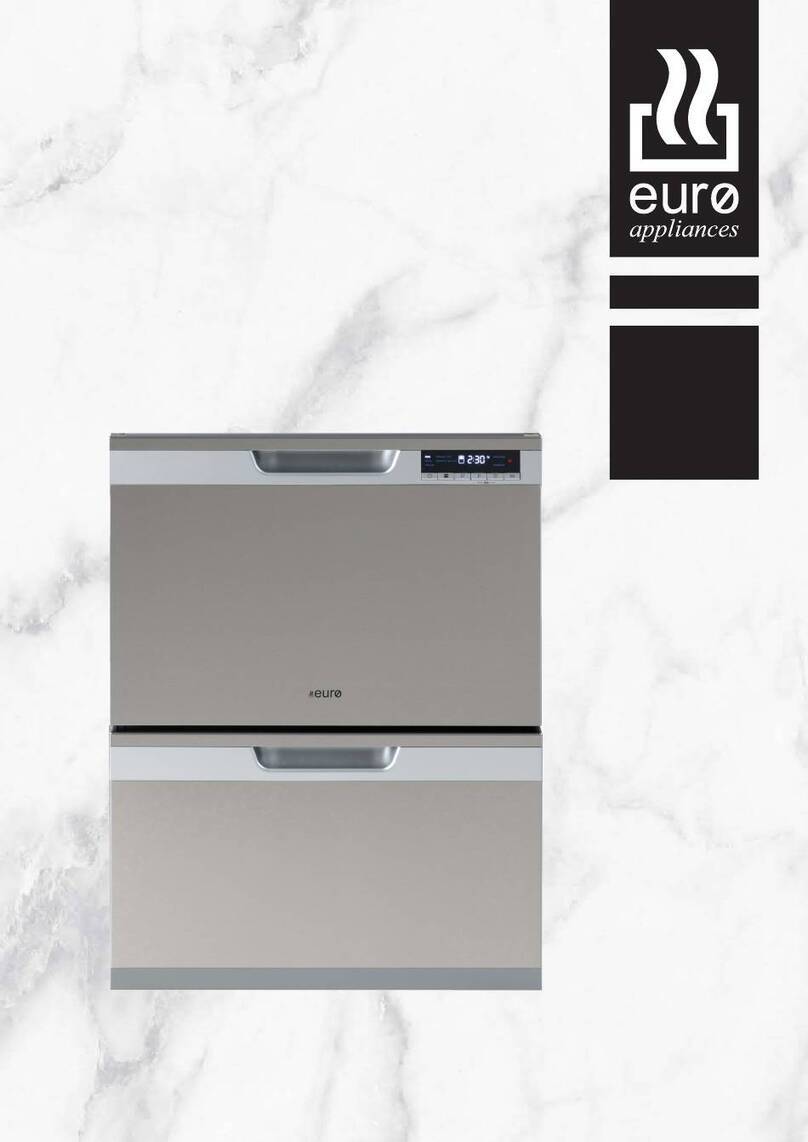
Euro Appliances
Euro Appliances EDD60S User manual

Euro Appliances
Euro Appliances PEDM15XS User manual

Euro Appliances
Euro Appliances EDV606SX User manual

Euro Appliances
Euro Appliances ED614SX User manual

Euro Appliances
Euro Appliances Vienna EDM15XS User manual

